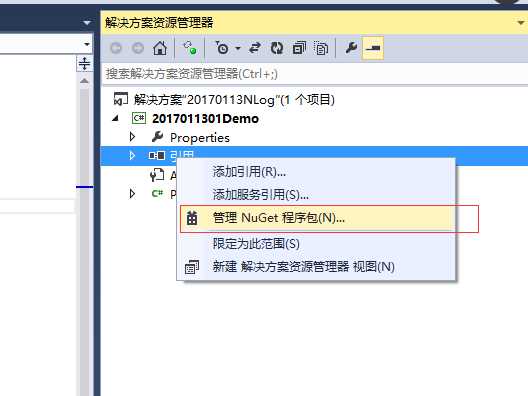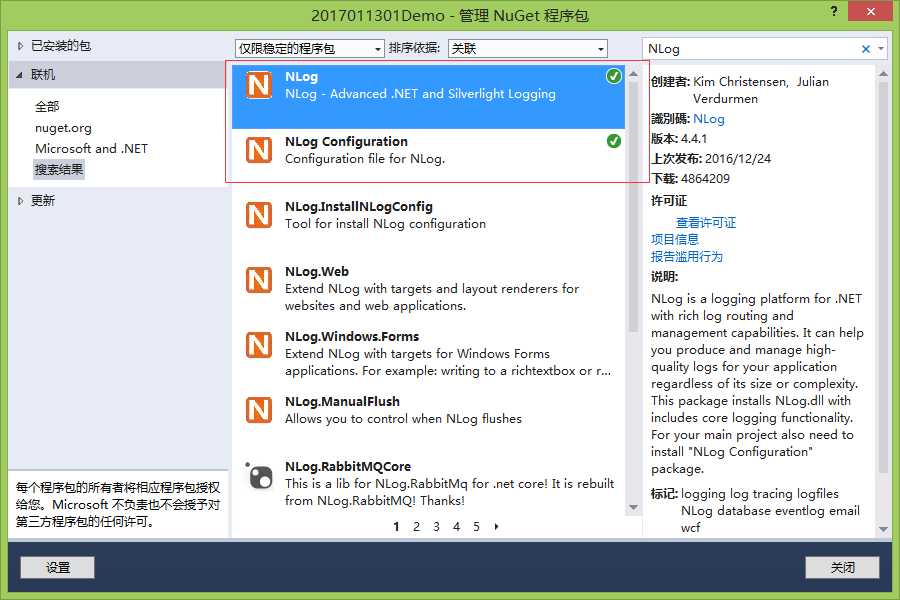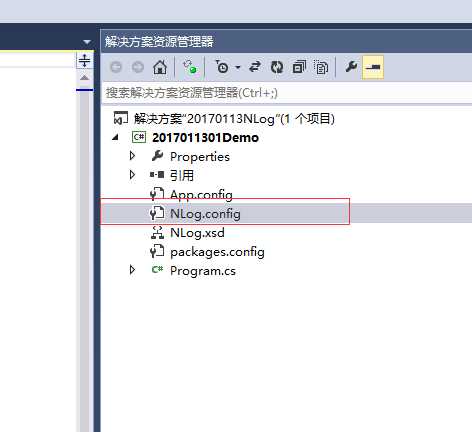NLog是一个基于.NET平台编写的类库,我们可以使用NLog在应用程序中添加极为完善的跟踪调试代码。
NLog是一个简单灵活的.NET日志记录类库。通过使用NLog,我们可以在任何一种.NET语言中输出带有上下文的(contextual information)调试诊断信息,根据喜好配置其表现样式之后发送到一个或多个输出目标(target)中。
NLog的API非常类似于log4net,且配置方式非常简单。NLog使用路由表(routing table)进行配置,这样就让NLog的配置文件非常容易阅读,并便于今后维护。
NLog遵从BSD license,即允许商业应用且完全开放源代码。任何人都可以免费使用并对其进行测试,然后通过邮件列表反馈问题以及建议。
NLog支持.NET、C/C++以及COM interop API,因此我们的程序、组件、包括用C++/COM 编写的遗留模块都可以通过同一个路由引擎将信息发送至NLog中。
简单来说Nlog就是用来记录项目日志的组件
NLog日志输出目标
文件 比如TXT、Excel
文本控制台
Email
数据库
网络中的其它计算机(通过TCP或UDP)
基于MSMQ的消息队列
Windows系统日志
NLog使用
直接用NuGet安装就行了




简单的Demo
<?xml version="1.0" encoding="utf-8" ?>
<nlog xmlns="http://www.nlog-project.org/schemas/NLog.xsd"
xmlns:xsi="http://www.w3.org/2001/XMLSchema-instance"
xsi:schemaLocation="http://www.nlog-project.org/schemas/NLog.xsd NLog.xsd"
autoReload="true"
throwExceptions="false"
internalLogLevel="Off"
internalLogFile="c: emp
log-internal.log">
<variable name="myvar" value="myvalue"/>
<targets>
<target xsi:type="File" name="SimpleDemoFile" fileName="../../../Logs/SimpleDemo.txt" layout="${message}" encoding="UTF-8"/>
</targets>
<rules>
<logger name="SimpleDemo" level="Error" writeTo="SimpleDemoFile"/>
</rules>
</nlog>
using NLog;
using System;
using System.Collections.Generic;
using System.Linq;
using System.Text;
using System.Threading.Tasks;
namespace _2017011301SimpleDemo
{
class Program
{
public static Logger logger = LogManager.GetLogger("SimpleDemo");
static void Main(string[] args)
{
Console.WriteLine("执行开始");
logger.Error("Hello World");
Console.WriteLine("执行结束");
Console.ReadKey();
}
}
}
输出到 ../../../Logs/SimpleDemo.txt 内容为 Hello World
NLog配置
<?xml version="1.0" encoding="utf-8" ?>
<nlog xmlns="http://www.nlog-project.org/schemas/NLog.xsd"
xmlns:xsi="http://www.w3.org/2001/XMLSchema-instance"
xsi:schemaLocation="http://www.nlog-project.org/schemas/NLog.xsd NLog.xsd"
autoReload="true"
throwExceptions="false"
internalLogLevel="Off“
internalLogFile="c: emp
log-internal.log">
<variable name="myvar" value="myvalue"/>
<targets> </targets>
<rules> </rules>
</nlog>
xmlns=“http://www.nlog-project.org/schemas/NLog.xsd” 这表示默认命名空间
xmlns:xsi="http://www.w3.org/2001/XMLSchema-instance" 这个命名空间里面的元素或者属性就必须要以xsi:这种方式来写
比如schemaLocation就是他的一个属性,所以写成xsi:schemaLocation
而默认命名空间不带类似xsi这种,其实xml标签名称有个专业叫法叫做QName,而如果没有前面的xsi:这种一般叫做NCName
xsi:schemaLocation="http://www.nlog-project.org/schemas/NLog.xsd NLog.xsd"
表示把定义这个命名空间的schema文件给引用进来,好让开发类型工具能够解析和验证你的xml文件是否符合语法规范
等同于
简单来说 上面是用来验证你XML格式是否正确的。
InternalLogFile="c:log
log.txt" //NLog内部日志文件位置
internalLogLevel="Debug" //日志级别
autoReload:一旦启动程序,这时候NLog.config文件被读取后,知道程序再启动都不会再读取配置文件了。假如我们不想停掉程序,比如说服务器哪能说停就停哈。这就用上这个配置了,这个配置功能是,一旦你对配置文件修改,程序将会重新读取配置文件,也就是自动再配置。
throwExceptions//NLog日志系统抛出异常
internalLogFile="c:log
log.txt" //NLog内部日志文件位置
internalLogLevel="Debug" //日志级别
<variable /> - 定义配置文件中用到的变量
<targets /> - 定义日志的目标/输出
<rules /> - 定义日志的路由规则
Layout布局
几种常见的
${var:basePath} basePath是前面自定义的变量
${longdate} 日期格式 2017-01-17 16:58:03.8667
${shortdate}日期格式 2017-01-17
${date:yyyyMMddHHmmssFFF} 日期 20170117165803866
${message} 输出内容
${guid} guid
${level}日志记录的等级
${logger} 配置的logger
NLog记录等级
Trace - 最常见的记录信息,一般用于普通输出
Debug - 同样是记录信息,不过出现的频率要比Trace少一些,一般用来调试程序
Info - 信息类型的消息
Warn - 警告信息,一般用于比较重要的场合
Error - 错误信息
Fatal - 致命异常信息。一般来讲,发生致命异常之后程序将无法继续执行。
自上而下,等级递增。
NLog等级使用
指定特定等级 如:level="Warn"
指定多个等级 如:levels=“Warn,Debug“ 以逗号隔开
指定等级范围 如:minlevel="Warn" maxlevel="Error"
Logger使用
从配置文件读取信息并初始化 两种常用的方式
根据配置的路由名获生成特定的logger Logger logger = LogManager.GetLogger("LoggerDemo");
初始化为当前命名空间下当前类的logger Logger logger = LogManager.GetCurrentClassLogger();
区别是logger的name不一样 前者是LoggerDemo,后者是当前命名空间+点+当前类名 如类比较多,并且往同一个日志文件记录,建议用GetCurrentClassLogger
Logger有以下三种常用的写入方式
logger.Error("这是DatabaseDemo的错误信息");
logger.Error(“ContentDemo {0}:{1}”,“时间”,DateTime.Now.ToString());需要拼接字符串的话推荐这种,NLog做了延迟处理,用的时候才拼接。
logger.Log(LogLevel.Error, "这是ContentDemo");
Logger发邮件参数
smtpServer=“*****” 邮件服务器 例如126邮箱是smtp.126.com
smtpPort=“25“端口
smtpAuthentication=“Basic“ 身份验证方式 基本
smtpUserName=“*****“ 邮件服务器用户名
smtpPassword=“******”邮件服务器密码
enableSsl=“false”是否使用安全连接 需要服务器支持
addNewLines=“true” 开头与结尾是否换行
from=“****” 发件邮箱
to=“[email protected],[email protected]”收件邮箱 多个以逗号分隔
subject=“subject:${machinename}报错“ 邮件主题
header=“---------------------开头-------------------------“ 邮件开头
body=“${newline}${message}${newline}“ 邮件内容
footer=“---------------------结尾-------------------------“ 邮件结尾
<?xml version="1.0" encoding="utf-8" ?>
<nlog xmlns="http://www.nlog-project.org/schemas/NLog.xsd"
xmlns:xsi="http://www.w3.org/2001/XMLSchema-instance"
xsi:schemaLocation="http://www.nlog-project.org/schemas/NLog.xsd NLog.xsd"
autoReload="true"
throwExceptions="true"
internalLogLevel="Off"
internalLogFile="c: emp
log-internal.log">
<!-- optional, add some variables
https://github.com/nlog/NLog/wiki/Configuration-file#variables
-->
<variable name="basePath" value="C:UsersacharyDesktop练习20170113NLogLogs"/>
<targets>
<target xsi:type="Mail"
name="SendMail"
smtpServer="你的邮件服务器"
smtpPort="你的邮件服务器端口"
smtpAuthentication="Basic"
smtpUserName="你的邮件服务器名"
smtpPassword="你的邮件服务器密码"
enableSsl="false"
addNewLines="false"
from="你的发件邮箱"
to="你的收件邮箱"
subject="subject:${machinename}报错"
header="---------------------开头-------------------------"
body="${newline}${message}${newline}"
footer="---------------------结尾-------------------------"
encoding="UTF-8"/>
</targets>
<rules>
<logger name="*" level="Error" writeTo="SendMail"></logger>
</rules>
</nlog>
Logger写入数据库参数
<target xsi:type="Database"
name="DatabaseFile"
dbProvider=“System.Data.SqlClient”数据库类型
commandText=“Insert into ErrorLog(ID, Content, CreateTime) Values(@id, @content, @createTime);”插入操作
connectionString=“data source=.;initial catalog=NLog;user id=sa;password=******;”> 数据库连接字符串 跟我们webcofig中的一样
<parameter name=“@id” layout=“${guid}” /> 参数
<parameter name="@content" layout="${message}" />
<parameter name="@createTime" layout="${date:format=yyyy-MM-dd HH:mm:ss.fff} " />
</target>
需在数据库里提前建好表
<?xml version="1.0" encoding="utf-8" ?>
<nlog xmlns="http://www.nlog-project.org/schemas/NLog.xsd"
xmlns:xsi="http://www.w3.org/2001/XMLSchema-instance"
xsi:schemaLocation="http://www.nlog-project.org/schemas/NLog.xsd NLog.xsd"
autoReload="true"
throwExceptions="true"
internalLogLevel="Off"
internalLogFile="../../../Logs/nlog-internal.log">
<targets>
<target xsi:type="Database"
name="DatabaseFile"
dbProvider="System.Data.SqlClient"
commandText="Insert into ErrorLog(ID, Content, CreateTime) Values(@id, @content, @createTime);"
connectionString="data source=.;initial catalog=NLog;user id=sa;password=你的数据库密码;">
<parameter name="@id" layout="${guid}" />
<parameter name="@content" layout="${message}" />
<parameter name="@createTime" layout="${date:format=yyyy-MM-dd HH:mm:ss.fff} " />
</target>
</targets>
<rules>
<logger name="Database" level="Error" writeTo="DatabaseFile"/>
</rules>
</nlog>
NLog.config可以单独放,也可以放在WebConfig里。
在configuration配置
<configSections>
<section name="nlog" type="NLog.Config.ConfigSectionHandler, NLog"/>
</configSections>
然后把NLog.config里面放在后面就行了。
<configuration>
<configSections>
<section name="nlog" type="NLog.Config.ConfigSectionHandler, NLog"/>
</configSections>
<nlog xmlns="http://www.nlog-project.org/schemas/NLog.xsd"
xmlns:xsi="http://www.w3.org/2001/XMLSchema-instance"
xsi:schemaLocation="http://www.nlog-project.org/schemas/NLog.xsd NLog.xsd"
autoReload="true"
throwExceptions="true"
internalLogLevel="Off"
internalLogFile="c: emp
log-internal.log">
<variable name="myvar" value="myvalue"/>
<targets async="false">
<target xsi:type="File" name="WebDemoFile" fileName="C:UsersacharyDesktop练习20170113NLogLogs${date:yyyyMMddHHmm}WebDemo.txt" layout="${longdate} ${message}" encoding="UTF-8"/>
</targets>
<rules>
<logger name="WebDemo" level="Error" writeTo="WebDemoFile"/>
</rules>
</nlog>
</configuration>
附demo+PPT介绍:http://download.csdn.net/detail/fcydxbd/9740809
